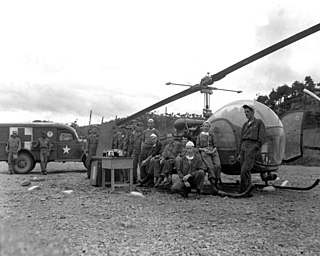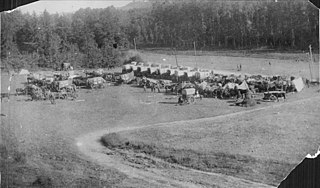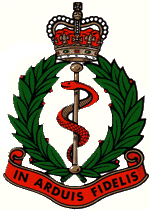
Battlefield medicine, also called field surgery and later combat casualty care, is the treatment of wounded combatants and non-combatants in or near an area of combat. Civilian medicine has been greatly advanced by procedures that were first developed to treat the wounds inflicted during combat. With the advent of advanced procedures and medical technology, even polytrauma can be survivable in modern wars. Battlefield medicine is a category of military medicine.

Mobile Army Surgical Hospitals (MASH) were U.S. Army field hospital units conceptualized in 1946 as replacements for the obsolete World War II-era Auxiliary Surgical Group hospital units. MASH units were in operation from the Korean War to the Gulf War before being phased out in the early 2000s, in favor of combat support hospitals.

A Combat Support Hospital is a type of modern United States Army field hospital. The CSH is transportable by aircraft and trucks and is normally delivered to the Corps Support Area in standard military-owned demountable containers (MILVAN) cargo containers. Once transported, it is assembled by the staff into a tent hospital to treat patients. Depending upon the operational environment, a CSH might also treat civilians and wounded enemy soldiers. The CSH is the successor to the Mobile Army Surgical Hospital (MASH).

A field hospital is a temporary hospital or mobile medical unit that takes care of casualties on-site before they can be safely transported to more permanent facilities. This term was initially used in military medicine, but it has also been used to describe alternate care sites used in disasters and other emergency situations.

A combat medic is responsible for providing emergency medical treatment at a point of wounding in a combat or training environment, as well as primary care and health protection and evacuation from a point of injury or illness. Additionally, medics may also be responsible for the creation, oversight, and execution of long-term patient care plans in consultation with or in the absence of a readily available doctor or advanced practice provider. Combat medics may be used in hospitals and clinics, where they have the opportunity to work in additional roles, such as operating medical and laboratory equipment and performing and assisting with procedures.

A field ambulance (FA) is the name used by the British Army and the armies of other Commonwealth nations to describe a mobile medical unit that treats wounded soldiers very close to the combat zone. In the British military medical system that developed during the First World War, the FAs formed an intermediate level in the casualty evacuation chain that stretched from the regimental aid posts near the front line and the casualty clearing stations located outside the range of the enemy's artillery. FAs were often assigned to the brigades of a division.
A combat medical technician (CMT) is a soldier with a specialist trade within the Royal Army Medical Service of the British Army.

This article incorporates public domain material from websites or documents of the United States Army.

The term military medicine has a number of potential connotations. It may mean:

This article incorporates public domain material from websites or documents of the United States Army.
15 (Edmonton) Field Ambulance is a Canadian Forces Primary Reserve medical unit headquartered in Edmonton, Alberta, with a detachment in Calgary. The unit's mission is to attract, train, force generate and retain high-quality health service personnel to provide health service support to the 41 Canadian Brigade Group and to augment CF's domestic and international operations. An additional and important activity is to participate in activities that will raise its profile in Edmonton and Calgary.

The history of the ambulance begins in ancient times, with the use of carts to transport patients. Ambulances were first used for emergency transport in 1487 by the Spanish forces during the siege of Málaga by the Catholic monarchs against the Emirate of Granada, and civilian variants were put into operation in the 1830s. Advances in technology throughout the 19th and 20th centuries led to the modern self-powered ambulance.

The 133rd (Parachute) Field Ambulance was a Royal Army Medical Corps unit of the British Army's airborne forces during the Second World War.

Lijssenthoek Military Cemetery is a Commonwealth War Graves Commission (CWGC) burial ground for the dead of the First World War in the Ypres Salient on the Western Front. After Tyne Cot, it is the second largest cemetery for Commonwealth forces in Belgium. Lijssenthoek Military Cemetery is located near Poperinge in the province of West Flanders. Most of those buried in the cemetery are war casualties who had been wounded near Ypres and later died in the four large Allied casualty clearing stations located in this area.

The 1st Medical Brigade is a medical brigade of the United States Army. It is located at Fort Cavazos, Texas, providing health care and medical services to the Fort Cavazos community, and continuing training in its combat support mission.

Though the United Kingdom remained neutral during the Franco-Prussian War of 1870–71, it provided ambulances and other medical assistance to both combatants and the civilians affected by the war. The term "ambulance" at this time denoted a medical organisation that provided field hospitals, transport and surgical operations, not the more limited modern use. The British public donated more than £300,000 to provide medical assistance during the war. The ambulances, together with those of other neutral organisations, proved very effective at treating casualties, and following the war all major powers took steps to implement similar arrangements for future wars.

Major-General Sir Edward Phillips was a British military doctor, who served throughout World War I, saw action in Afghanistan/North West Frontier, the Middle East and was then a leading medical officer in the British Army through World War II in Africa, Italy, D-Day, the liberation of Bergen-Belsen concentration camp and the establishment of the British Army of the Rhine. He had "arguably the most distinguished field service career of any Army doctor of this [the 20th] century".

The 68th Medical Command was constituted on 18 October 1927 in the Regular Army as the 18th Medical Regiment. Redesignated as the 68th Medical Regiment and reorganized as the 68th Medical Group, the organization served in combat in Europe in World War II and in the Republic of Vietnam. During the Cold War, it was stationed at Fort George G. Meade, Maryland from 1954 until its deployment to Vietnam and was reactivated again in Germany, where it served from 1978 into the 1990s. On 21 September 2024, it was redesignated as the 68th Medical Command and activated at Sembach, Germany.

The 211 (Wessex) Field Hospital was a field hospital of the British Army forming part of the Royal Army Medical Corps. Formed in 1967 and disbanded in 1996, the hospital's remaining detachments continue to serve in its successor unit, the 243 Field Hospital.
The 219th (Wessex) Field Hospital was a field hospital of the British Army forming part of the Royal Army Medical Corps. Though short-lived having been formed in 1967 and disbanded in 1996, the hospital's remaining detachments continue to serve in its successor unit, the 243rd Field Hospital.
















